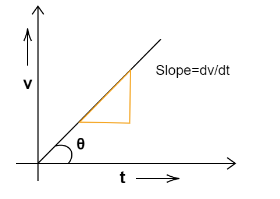
The acceleration of a moving body can be found from:
(A) Slope of velocity-time graph
(B) Area under velocity-time graph
(C) Slope of distance-time graph
(D) Area under distance-time graph
Answer
552k+ views
Hint: We will use the basic definition of acceleration in order to solve this question which states that the rate of change in velocity of an object gives the acceleration. This is a vector quantity which is having both magnitude and direction. This will help you in solving this question.
Complete step-by-step solution
The acceleration can be figured out by taking the rate of variation of the velocity of a body with respect to the time taken. When a body is moving from one point to another at a specific time, its velocity will change. Because a body is going from one point to another and the change in velocity does not keep on constant. Therefore the slope of the velocity-time curve will be equivalent to the tangent of the angle between the curve and time axis. This will be comparable to the first derivative of the velocity.
$ \tan \theta = \dfrac{{dv}}{{dt}} $
where $ \theta $ be the angle between the curve and the time axis. For that reason, the slope of a velocity-time graph will be the acceleration. This has been mentioned as an option (A).

So, the correct answer is option (A) Slope of the velocity-time graph.
Note
The slope of the line on a velocity-time graph depicts valuable information about the acceleration of the body. When the acceleration is zero, then the slope also tends to be zero. That means the horizontal line. If the acceleration is positive, the slope will also be positive. Also, recall that the area under the velocity-time graph provides the distance covered by the object.
Complete step-by-step solution
The acceleration can be figured out by taking the rate of variation of the velocity of a body with respect to the time taken. When a body is moving from one point to another at a specific time, its velocity will change. Because a body is going from one point to another and the change in velocity does not keep on constant. Therefore the slope of the velocity-time curve will be equivalent to the tangent of the angle between the curve and time axis. This will be comparable to the first derivative of the velocity.
$ \tan \theta = \dfrac{{dv}}{{dt}} $
where $ \theta $ be the angle between the curve and the time axis. For that reason, the slope of a velocity-time graph will be the acceleration. This has been mentioned as an option (A).

So, the correct answer is option (A) Slope of the velocity-time graph.
Note
The slope of the line on a velocity-time graph depicts valuable information about the acceleration of the body. When the acceleration is zero, then the slope also tends to be zero. That means the horizontal line. If the acceleration is positive, the slope will also be positive. Also, recall that the area under the velocity-time graph provides the distance covered by the object.
Recently Updated Pages
Master Class 11 Economics: Engaging Questions & Answers for Success

Master Class 11 English: Engaging Questions & Answers for Success

Master Class 11 Social Science: Engaging Questions & Answers for Success

Master Class 11 Biology: Engaging Questions & Answers for Success

Class 11 Question and Answer - Your Ultimate Solutions Guide

Master Class 11 Business Studies: Engaging Questions & Answers for Success

Trending doubts
10 examples of friction in our daily life

One Metric ton is equal to kg A 10000 B 1000 C 100 class 11 physics CBSE

Difference Between Prokaryotic Cells and Eukaryotic Cells

1 Quintal is equal to a 110 kg b 10 kg c 100kg d 1000 class 11 physics CBSE

Explain zero factorial class 11 maths CBSE

What is a periderm How does periderm formation take class 11 biology CBSE




